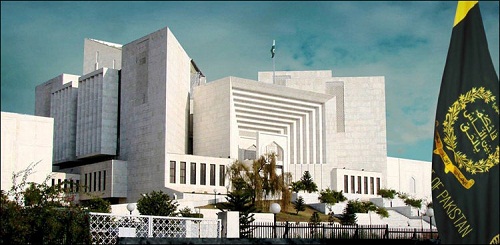Opening the Halls of Justice: Balancing Rights and Judicial Authority
ARTICLE

Transparency and accountability stand as the cornerstones of trust in a nation’s judicial system. Regrettably, Pakistan, despite its democratic ideals, has contended with challenges in its judiciary. However, the winds of change are blowing, driven by technological innovation, breathing hope into the system. Pakistan is charting a course toward a future illuminated by transparency, one that upholds democracy and fundamental rights. Among the pioneering developments, the live-streaming of Supreme Court hearings takes center stage. Pakistan witnessed a historic moment as, for the very first time, the Supreme Court opened its doors to public scrutiny by allowing the telecast of proceedings. This momentous step forward was championed by the recently appointed Chief Justice.
Ever wondered whether this revolutionary initiative can skillfully thread the complex labyrinth where press freedom, the radiance of transparency, and unbridled public access to information meet the formidable bulwarks of fair trials and privacy? Can this initiative strike the perfect chord, ensuring that the scales of justice remain undisturbed, even as the light of transparency shines brighter? Additionally, how does it impact on legal proceedings? This article delves into these intriguing questions and also underscores the imperative of regulatory measures to ensure the preservation of our Constitutional commitments.
In the heart of Pakistan’s constitutional framework lies a powerful guarantee, one that resonates with the essence of democracy itself. Article 19-A declares that ‘Every citizen shall have the right to have access to information in all matters of public importance subject to regulation and reasonable restriction imposed by law.’ This fundamental right is not just a legal provision; it’s the lifeblood of a vibrant democracy like Pakistan. It acts as a custodian of accountability, transparency, and good governance and holds our institutions and public officials to the highest standards of integrity, ensuring that their actions are subject to scrutiny. Not just this, this is an empowering tool that places the decisions about our society and government directly into the hands of our citizens, beckoning them to participate actively in shaping their future.
The equation is simple pertaining to governance that the secrecy breeds corruption and inefficiency, while transparency fuels diligence and trust. By granting the public access to information, especially when it comes to our government and courts, we not only enhance their efficiency but also diminish concerns about miscarriages of justice, errors, and corruption. When it comes to decision-making, it’s imperative that the choices made by our leaders are well-informed and firmly rooted in the public interest. Transparency, in the form of live-streaming proceedings, becomes a critical instrument in achieving this goal. Across the globe, top-tier courts have echoed this sentiment, recognizing the profound importance of openness. As the eminent Chief Justice Burger once aptly noted,
“A trial courtroom is a public place where the people generally and representatives of the media have a right to be present, and where their presence historically has been thought to enhance the integrity and quality of what takes place.”
Another line of argument that supports the live streaming is that governments are custodians of the state’s information, entrusted to convey it to the citizens unless a compelling reason, such as the protection of National Security, prevents disclosure. This bond of trust between the state and its people underscores the significance of transparency in every facet of democracy. Citizens’ active engagement is a vital foundation in developing a robust and sustainable democratic society. It’s the people’s gateway to unfiltered government information, particularly when the democratic process is in full swing, such as during elections. This information isn’t just useful; it’s the essential element that sustains the democratic spirit. Without it, the legitimacy of our democratic system starts to wobble.
Beyond safeguarding democracy, our Constitution, under Article 19, protects the Freedom of Speech, a cornerstone of our liberties. Live streaming opens the floodgates for journalists and media professionals to exercise this right fully. It not only simplifies data collection and transmission but also acts as a bulwark against misinformation and manipulation. But the benefits don’t stop there. Think about the educational boon! Open access to the inner workings of our legal system elevates our collective awareness of legal complexities and offers a glimpse into the minds of judges and lawyers. The proof can be seen in a March 2016 report by the United States Federal Judicial Center, where a majority of viewers were students, lawyers, and everyday folks seeking to broaden their horizons without the hassle of court visits.
Moreover, in an ever-changing world, ensuring our citizens are well-informed about their rights and responsibilities is paramount. We can’t afford a society in the dark. Pakistan isn’t just a nation; it’s a signatory to international commitments like the Universal Declaration of Human Rights, which demands the right to information. We’ve got to uphold these promises. Our judicial system is evolving, and embracing live streaming is a pivotal step. It’s about strengthening our democracy, upholding the rule of law, and flourishing trust in our institutions. Remember those times when society scratched its head, baffled by decisions it couldn’t quite grasp? Those days are numbered.
However, like any transformative step, live streaming is not without its concerns. Practical issues have surfaced, with media disruptions potentially interfering with the sanctity of the courtroom. The right to a fair trial, a cornerstone of justice, is put at risk when the cacophony of cameras and microphones drowns out the solemnity of the legal process.
There is also a concern about unwarranted public meddling in sensitive matters, potentially swaying case outcomes or compromising the safety of witnesses and parties involved. Yet, we find solace in the evolving legal landscape. Technological advancements have solutions to the challenges posed. Just as Estes v Texas dealt with the distracting nature of broadcasting, today’s courts have found ways to balance transparency with decorum. The Supreme Court’s decision in Chandler v Florida, diverging from Estes, reflects this evolving stance. Looking beyond our borders, Canada’s courts offer valuable insights. They have utilized technology to strike a balance, installing unobtrusive cameras that minimize media presence while preserving the essence of justice. The Canadian Charter of Rights and Freedoms serves as a beacon of guidance for Pakistan’s journey toward judicial transparency.
Lastly, sustaining the delicate balance between upholding fundamental Constitutional Rights, notably the Right to Privacy and the Right to a Fair Trial, and the emerging practice of live-streaming court proceedings is another concern. The pivotal question lingers: Should this practice be enshrined as a Constitutional Right? In India, for instance, the right to live-stream court sessions is regarded as a Constitutional privilege, albeit with judicious restrictions in place, particularly in sensitive cases involving minors or sexual assault. Contrastingly, the United States grapples with an ongoing debate, with no unanimous consensus on its Constitutional status. Consider the precedent set in Nebraska Press Association v Stuart, where the Supreme Court allowed the live streaming of a widely known criminal case but retained the prerogative to intervene in cases where the right to fair trial might be compromised. This exemplifies the refined approach in directing the intersection of technology and justice. Also, the Canadian Supreme Court’s landmark Dagenais decision in 1994 underscores the imperative of striking a delicate balance between the Right to a Fair Trial and Freedom of Expression when deciding on media coverage. This thoughtful approach has reverberated in jurisdictions such as the United States and Britain, where it has paved the way for both de jure coverage and delegated the authority for de facto coverage to the courts.
In conclusion, there is the critical need for a thoughtful exploration of the far-reaching impact of audio-visual coverage within courtrooms. While the benefits of transparency and accessibility are undeniable, Pakistan must tread cautiously, cognizant of potential pitfalls. Our approach should craft policies that deftly balance the scales, conforming openness with the sacrosanct right to a fair trial. These policies should provide judges with clear-cut guidelines to illuminate their path in decisions regarding courtroom coverage, favoring its implementation while ensuring that the voices of litigants and their counsel are heard in this deliberative process, without bestowing upon them undue authority. Also, the conventional notion of public interest as the sole rationale for live broadcasts warrants a thorough reevaluation. It should be one facet of a broader spectrum of considerations when determining coverage. In this ever-evolving technological landscape, adaptability in policy making becomes paramount, as digital innovations continually challenge legal norms. We must remain nimble, with policymakers ready to respond to the shifting digital terrain. It’s evident that while constitutional principles hold sway, they share the stage with the judiciary’s discretion in molding policies governing courtroom proceedings. Amid this dynamic transformation, our focus should revolve around comprehending the judiciary’s perspective, delving into empirical data on the impact of coverage, and studying the diverse approaches adopted globally to address the concerns while preserving the judiciary’s institutional authority.

